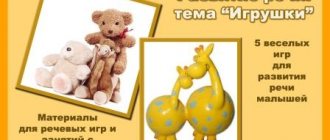Games for developing speaking skills
The basis for such games is ordinary speech. The child gains useful experience of fluent and grammatically correct spoken language. Games are useful for stimulating positive emotions if a child has isolated himself, withdrawn, or become offended.
"Skilled rhymers." It is useful to turn to such a game when you are offended by a peer, brother or sister.
Make up, make up, make up and don’t fight anymore, and if you fight, you’ll be left without a friend.
* Hey, hand, shake, shake, just don’t fight anymore.
* Relax your hand, relax and don’t pinch anymore.
* Oh, my hand is stuck! I let go of my hand and grab him by the body. You call it good, I let go of my hand.
Playful rhymes to help you overcome feelings of resentment.
Take away the insult - you are forgotten anyway,
Run into the yard, climb over the fence,
Get on your horse and ride away from me!
Staging children's speech through different types of activities
Apart from those mentioned above, there are some other great ways that you can naturally stimulate speech development in children. Let's look at them in more detail.
Reading
Read as many books as possible with your children. While reading, ask them to guess what will happen next and how the story will end. Just stop reading and ask the kids to tell their side of the story. When children hear new words in a certain context, they remember their meaning much more easily, and this in turn stimulates the development of speech in children. They will retell the story they heard, using words that are new to them. While reading books, you can also talk about the pictures and discuss them. For example, you can ask your child the name of his dog while you are reading a book about dogs.
Dialogue
Talk to your children. Research has shown that listening to your child is just as important as talking to him. Simply talking to your baby about his actions is not enough to effectively develop speech. You need to maintain a dialogue and listen carefully to what your child says. Help your baby enter into a dialogue with you by asking various questions and repeating phrases. For example, ask your child, “Which sandwich do you want: peanut butter or cheese?” The kid will answer: “With cheese.” Then you should continue: “With cheese? Do you want a cheese sandwich? Okay, I’ll make a cheese sandwich for you and myself now.”
Explanations
Encourage your child to talk about the objects he sees around him. Using questions, encourage your child to learn to explain ordinary objects and phenomena. For example, ask your child what he had for breakfast and then follow up with food-related questions.
Development of a child's grammatical abilities
These games help develop children's grammatical abilities without cramming the letters of the alphabet, without the dull reading of syllables from a book.
"Let's remember the letters." Goal: to help the child remember the letters of the alphabet, relying on auditory, visual, and muscle memory.
* An adult traces the letter along the outline, naming it, and the child shades the letter with a pencil or paints it over.
* The adult draws the outlines of the intended letter in the air, the child tries to guess and name it. In a similar way, an adult draws a letter on the child’s back.
* The letter is molded from plasticine, constructed from matches, counting sticks, and seeds.
* An adult and a child take turns naming the similarity of a letter with objects from the surrounding world.
"Hide and seek with letters." Goal: to train intelligence, imagination, and the ability to recognize familiar letters in graphic contours.
A simple pattern is drawn on a sheet of paper, on sand, on asphalt. You need to look closely at it, see the outlines of letters in its lines and show them in the pattern along the contour one by one.
Learning to write and read
Moms and dads strive for their child to learn to read and write as early as possible. But psychologists and neurologists do not recommend doing this. Firstly, the child must master new skills in a timely manner (and earlier does not always mean better), and secondly, children need to be taught using a special method. It is owned by kindergarten teachers and primary school teachers, but parents can make many mistakes and only harm their child.
Instead, focus on preparing to master new skills.
Learn sounds. Moms and dads often teach their children letters, but this is wrong. Words are built not on letters, but on sounds.
Train your articulation apparatus. This is the key to correct pronunciation.
Learn to write in block letters, not in capital letters. Schools use the continuous writing method. Other techniques will only do harm; the student will have to relearn, and this is much more difficult.
Get your little hand ready to write. Let him draw, cut out, hatch, paint, put together a mosaic, draw dots on checkered paper - this trains fine motor skills, muscles, and develops spatial orientation.
Let's talk separately about the sound-letter analysis of words. This is where preschoolers begin to be taught to read.
Learn to read step by step
Stage one - learning sounds.
- Start by learning a group of sounds. Use a primer or alphabet - learn in the same sequence.
- Tell us about vowels and consonants. How to pronounce them (drawn out, abruptly), how they differ.
- Tell us about syllables. Show how you can make a syllable from two sounds. Talk about the difference between letters (they are written) and sounds (they are pronounced). Show examples, for example “ma”, “sha”, “ra”, “ma”.
- It is correct to teach your child: “b”, “p”, “v”, and not the letters “be”, “pe”, “ve”. Otherwise, the daughter or son will read letter by letter: “Me - a - sha - a”, place “Ma-sha”. It will be more difficult and longer for him to learn to read by syllables, then by words. Complex words will even look like puzzles: “a - ve - te - o - be - y - es” instead of “av-to-bus” is much more difficult to perceive.
Stage two - read:
- We learn to combine sounds into syllables. Task for the baby: pronounce the first sound in the word until he reads the second: “m-m-m-m-a-a”;
- Finding syllables in a word. Assignment: ask your son or daughter to find certain combinations of letters in a word. Let him read them;
- We make up new words. Ask your child to make up a few words from familiar syllables and read them;
- Adding sounds. The baby adds one sound to familiar syllables, reads, composes new syllables, words;
- Learning to read closed syllables. First, show the difference between an open (“ka”) and a closed (“an”) syllable.
If the preschooler has completed these stages successfully, you can complicate the task - move on to more complex words, and then to sentences.
Pay attention to the fact that the child puts the emphasis correctly and understands the meaning of the words read. If he doesn’t understand, explain. Practice in the form of a game.
Fun ABC lesson
This group of games helps children learn a lot of new things from the life of words, expand their vocabulary, and knowledge about language.
Ball game "Say the opposite."
Winter summer. Heat - cold. True False. Rich man - poor man. Bitter - sweet. Useful - harmful...
"The Magic Wand of the Fairy Slovarina"
To play you need a “magic” wand. One end of the stick decreases, and the other increases.
An adult player names a word, then touches one of the children with a stick. The child calls this word either diminutive or increasing, depending on the end of the stick with which the child was touched.
House - house - house. Bridge - bridge - bridge. Rain - rain - rain. Cat - cat - cat...
Author: Krugovykh Margarita Aleksandrovna
Senior teacher of MADOU d/s No. 7 in Ishim
Everyone knows what an important function breathing performs in the life of the human body. In addition to its main physiological function - gas exchange - breathing also provides such a function as speech breathing. Speech breathing (diaphragmatic) is the basis of sounding speech, the source of the formation of sounds and voices.
The mechanism of this type of breathing is inherent in us from the very beginning. This is the oldest type of breathing, inherent in all warm-blooded animals and 90% of the total need for breathing is carried out due to it.
The main muscle that powers this type of breathing is the diaphragm . It separates the abdominal and thoracic cavities. When you inhale, the diaphragm relaxes and, falling, presses on the abdominal organs, which in turn are pressed against the abdominal wall, causing it to protrude and round. As you exhale, the diaphragm contracts, compresses the lungs, and the abdominal wall retracts. In this case, the upper part of the chest remains motionless. Outwardly, it looks like belly breathing.
When correcting speech disorders, there is a need to specially organize and develop speech breathing; breathing exercises become of particular importance. The corresponding gymnastics is aimed at developing in children the skills of correct rational breathing and voluntary control of the process of air flow movement.
Speech didactic games as a type of activity
Play is a basic personal need in the preschool period of a child’s development, therefore it is necessary to organize the educational process in such a way as to use the interest and desires of preschoolers for pedagogical purposes. Properly organized game activities, visual and didactic material, and a comfortable psychological atmosphere ensure not only the transfer of necessary knowledge, mastery of age-appropriate skills, but also the formation of a certain level of culture.
For a child with a speech delay, communicating and satisfying life's needs and desires, namely the inability to satisfy them because they are not understood or they cannot express them, can lead to great disappointment and negatively affect personal development .
Both parents and teachers can use didactic games to help their child with speech development. When a diagnosis has been made, you can select didactic games on the relevant problem and focus on those that are effective, interesting, exciting, enrich your inner world, and broaden your horizons.
Types of didactic games that develop speech
Teachers distinguish three types of didactic games: games with objects (toys), board-printed games, and word games.
Didactic games of the first and second types develop tactility and motor skills, promote the activation of attention and thinking, the actualization of existing knowledge and skills, the development of visual memory, and creative imagination.
Verbal didactic games are used in pedagogical activities in organizing the educational and correctional process to solve problems with speech development in children. Words and actions are the main tools for play activities with preschoolers. Verbal didactic games develop dialogical speech skills and activate attention. Such games serve as a means of developing memory, attention, coherent dialogical speech, and form a vocabulary for expressing one’s desires and thoughts. They practice correct sound pronunciation, clarifying and consolidating articulation, and contribute to the activation of vocabulary.
Rules for organizing and conducting didactic games for speech development
In order for the results of didactic games and all correctional work to be positive, it is necessary to follow a number of instructions.
- Before choosing a game, you should study the child’s interests, take them into account, encourage communication and participation in the game.
- The collaboration of the speech therapist and the parent will ensure that play therapy methods are used regularly, this is important because children with speech delays need constant repetition.
- Experience in using didactic games has shown that an environment conducive to speech development is needed. The opportunity to communicate with peers during the game gives the child great advantages, because a communication situation is modeled, children learn from each other.
- Reading and singing while playing provides the child with the opportunity to increase the frequency of sounds, the use of words and provides sentence structure.
- A child with speech delays will benefit greatly from using simple sign language. It provides another way to communicate, helps to participate in the game and satisfy communication needs. Simple signs like “yes”, “no”, “more”, days of the week and seasons will be useful, easy and relevant.
- Playful activities will create a more comfortable atmosphere if visual cues are used to encourage communication. These can be cards, symbols, images and any other visual aids.









